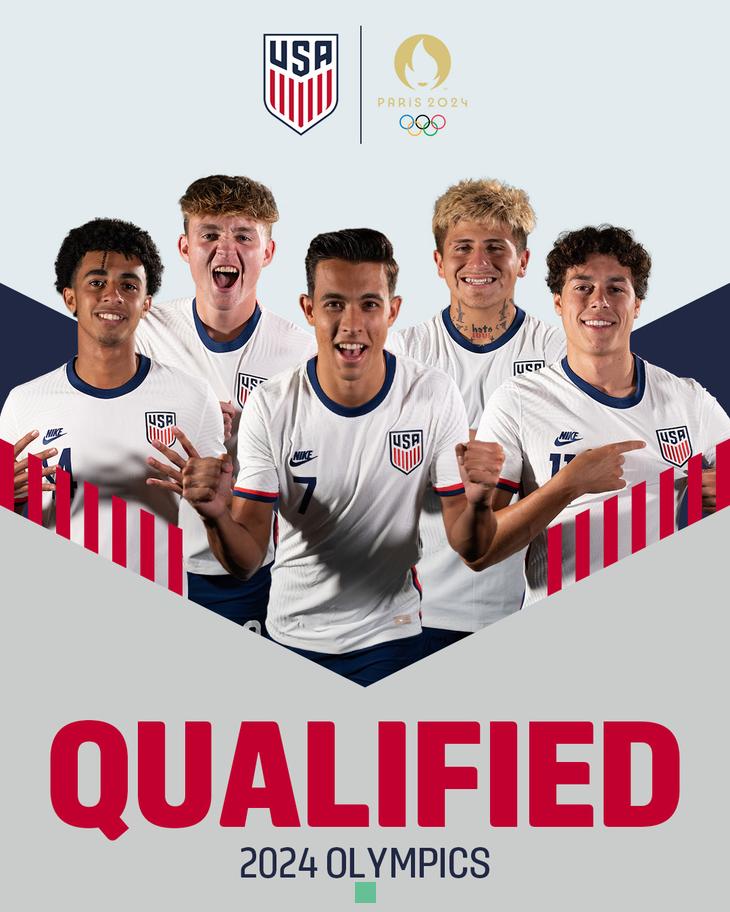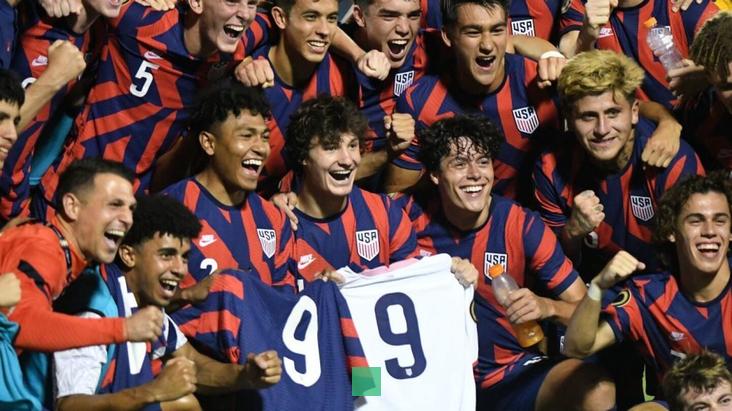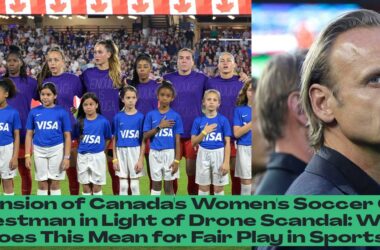Why U.S. Soccer Men and Women Have Different Jerseys at Paris 2024 Olympics: USMNT, USWNT Adjust for IOC Rules

As the world’s eyes turn to Paris for the 2024 Summer Olympics, a curious detail has caught the attention of soccer fans: the jerseys worn by the U.S. men’s and women’s national teams are different from their usual attire. While viewers might be accustomed to seeing the familiar crests and logos of the U.S. Soccer Federation (USSF) adorning the kits at international tournaments, the Olympic Games have a different dress code. The International Olympic Committee (IOC) has strict regulations regarding team apparel, emphasizing the promotion of national unity over commercial branding.
This means that the iconic USSF crest, the “USMNT” and “USWNT” logos, and other signature markings are replaced with a more generic, temporary badge based on the national flag. This directive stems from the IOC’s desire to maintain uniformity and visibility of national identity across all participating teams. The organization believes that the use of generic team emblems allows each country’s presence at the Olympics to be highlighted, rather than emphasizing specific federations or sponsorships.
The IOC’s rules are not just a suggestion; they are strictly enforced. Teams that fail to comply with the regulations face hefty fines. This explains why the U.S. teams, along with many other nations, have opted to wear unique Olympic-specific jerseys, showcasing their national colors, flag, and emblems in a unified manner. The IOC’s Team Apparel Guidelines state, “NOCs are encouraged to use their national colors, name, flag and emblems, as well as NOC Emblems (together, National Identifications), in order to visually enhance the national identity of their Apparel.”
The IOC’s directive is driven by a desire to foster a sense of global unity and sportsmanship. By emphasizing national identity over commercial branding, the organization aims to create an atmosphere where athletes compete on a level playing field, representing their countries with pride. While the absence of the familiar USSF crest might be a subtle shift, it’s a reflection of the IOC’s overarching vision for the Olympics: to celebrate nations coming together to achieve sporting greatness.
- The U.S. men’s and women’s national soccer teams wear different jerseys at the Paris 2024 Olympics due to strict regulations set by the International Olympic Committee (IOC).
- The IOC emphasizes promoting national unity over commercial branding, leading to the replacement of familiar USSF crests and logos with temporary badges based on the national flag.
- Teams failing to comply with IOC regulations face hefty fines, prompting many nations, including the U.S., to opt for unique Olympic-specific jerseys showcasing their national colors and emblems.
- The IOC’s Team Apparel Guidelines encourage the use of national colors, flags, and emblems to enhance the visual representation of each country’s identity during the Olympics.
- By prioritizing national identity over commercial branding, the IOC aims to create a sense of global unity and sportsmanship among athletes competing on a level playing field.
Reasons Behind the Jersey Changes: USMNT and USWNT Adapting to IOC Regulations
The shift in jersey design for the U.S. men’s and women’s national teams at the Paris 2024 Olympics is not a random occurrence. It’s a deliberate adaptation to the stringent guidelines set by the International Olympic Committee (IOC). The IOC’s Team Apparel Guidelines, which are meticulously enforced, aim to ensure that all participating teams project a consistent visual identity centered around national pride and unity.
The IOC’s regulations specifically target the use of federation logos and crests, which are seen as promoting commercial interests rather than celebrating national representation. To address this, the IOC mandates the use of generic temporary badges based on the national flag, replacing the normally prominent federation emblems. This shift is evident in the U.S. teams’ jerseys, where the familiar USSF crest is replaced with a simpler, flag-inspired design.
The IOC’s guidelines also extend to other branding elements. For example, the “USMNT” and “USWNT” logos, which are typically present on the jerseys, are also absent in the Olympic versions. This reinforces the focus on national identity, ensuring that the teams’ uniforms prominently feature the country’s flag and name. This change might feel unfamiliar to fans accustomed to seeing the traditional logos, but it underscores the IOC’s commitment to maintaining a unified visual aesthetic across all participating teams.
The IOC’s approach to team apparel highlights the organization’s overarching goal: to create an atmosphere where athletes compete on a level playing field, representing their countries with pride and sportsmanship. While the absence of specific federation logos might seem minor, it’s a deliberate choice that underscores the IOC’s vision for the Olympics as a celebration of global unity and athletic excellence.
Explanation Behind U.S. Soccer Male and Female Teams Sporting Distinct Jerseys at Paris 2024 Olympics: USMNT, USWNT Modifying for IOC Guidelines

The distinct jerseys worn by the U.S. men’s and women’s national teams at the Paris 2024 Olympics are not just a fashion statement. They are a testament to the International Olympic Committee’s (IOC) strict regulations regarding team apparel. The IOC, which oversees the Olympic Games, has a clear vision: to create a visual landscape where national pride takes center stage and commercial branding takes a backseat.
This vision is reflected in the IOC’s Team Apparel Guidelines, which are meticulously enforced. The guidelines emphasize the use of national colors, names, flags, and emblems, ensuring that each participating team projects a unified visual identity that reflects its national origin. As a result, the iconic crests and logos of the U.S. Soccer Federation (USSF), typically seen on the jerseys at other international tournaments, are absent in the Olympic versions.
To comply with the IOC’s mandate, the U.S. teams have opted for a simpler, temporary badge based on the national flag. This change, although subtle, is a key element in promoting national unity over commercial branding. The IOC’s regulations also extend to other branding elements, such as the “USMNT” and “USWNT” logos, which are also absent on the Olympic jerseys. This further reinforces the focus on national representation, ensuring that the teams’ uniforms prominently feature the country’s flag and name.
The IOC’s approach to team apparel, while seemingly minor, is a testament to the organization’s commitment to fostering a sense of global unity and sportsmanship. By emphasizing national identity over commercial branding, the IOC creates an atmosphere where athletes compete on a level playing field, representing their countries with pride. The unique Olympic jerseys worn by the U.S. teams serve as a powerful reminder of this vision, highlighting the significance of national representation in the global stage of the Olympic Games.
Why U.S. Soccer Men’s and Women’s Teams Have Varying Jerseys at Paris 2024 Olympics: USMNT, USWNT Conforming to IOC Rules
The varying jerseys worn by the U.S. men’s and women’s national soccer teams at the Paris 2024 Olympics are not a random choice; they are a strategic adaptation to the International Olympic Committee’s (IOC) strict guidelines on team apparel. The IOC, the governing body for the Olympic Games, has a clear vision for how participating teams should visually represent themselves: national pride over commercial branding.
This vision is codified in the IOC’s Team Apparel Guidelines, which are meticulously enforced. The guidelines emphasize the use of national colors, names, flags, and emblems, ensuring that each team projects a unified visual identity that reflects its national origin. This means that the iconic crests and logos of the U.S. Soccer Federation (USSF), typically seen on the jerseys at other international tournaments, are absent in the Olympic versions. Instead, the U.S. teams wear temporary badges based on the national flag, promoting a unified look across all competing nations.
The IOC’s regulations extend beyond federation logos, also addressing the use of team-specific markings. The “USMNT” and “USWNT” logos, commonly seen on the jerseys, are also absent in the Olympic versions. This further emphasizes national representation, ensuring that the uniforms prominently feature the country’s flag and name. The shift in jersey design might seem insignificant to casual viewers, but it reflects the IOC’s commitment to creating an atmosphere where athletes compete on a level playing field, representing their countries with pride and unity.
The IOC’s approach to team apparel underscores the organization’s overarching goal: promoting global unity and sportsmanship. The unique Olympic jerseys, while different from the typical kits, serve as a powerful reminder of the vision for the Olympics as a celebration of athletic excellence and national pride.
Causes for U.S. Soccer Men and Women to Have Dissimilar Jerseys at Paris 2024 Olympics: USMNT, USWNT Adjusting as Per IOC Regulations
The distinct jerseys worn by the U.S. men’s and women’s national soccer teams at the Paris 2024 Olympics are not a matter of choice but a necessary adaptation to the International Olympic Committee’s (IOC) stringent guidelines on team apparel. The IOC, the governing body for the Olympic Games, has a clear vision for the visual representation of participating teams: national pride over commercial branding.
This vision is enshrined in the IOC’s Team Apparel Guidelines, which are meticulously enforced. The guidelines emphasize the use of national colors, names, flags, and emblems, ensuring that each team projects a unified visual identity rooted in its national origin. This means that the iconic crests and logos of the U.S. Soccer Federation (USSF), typically seen on the jerseys at other international tournaments, are replaced in the Olympic versions with temporary badges based on the national flag, promoting a unified look across all competing nations.
The IOC’s regulations also extend to the use of team-specific markings. The “USMNT” and “USWNT” logos, commonly seen on the jerseys, are also absent in the Olympic versions. This further emphasizes national representation, ensuring that the uniforms prominently feature the country’s flag and name. The shift in jersey design, while subtle, reflects the IOC’s commitment to creating an atmosphere where athletes compete on a level playing field, representing their countries with pride and unity.
The IOC’s approach to team apparel underscores the organization’s overarching goal: promoting global unity and sportsmanship. The unique Olympic jerseys, while distinct from the typical kits, serve as a powerful reminder of the vision for the Olympics as a celebration of athletic excellence and national pride.









